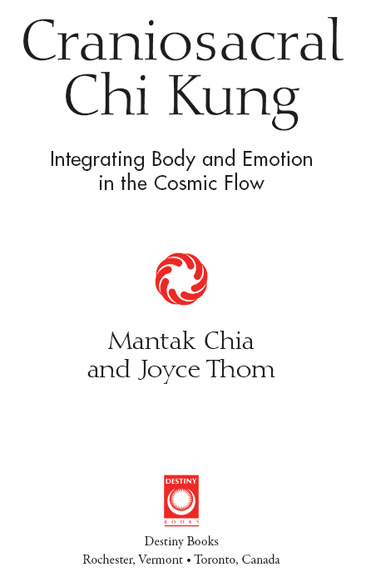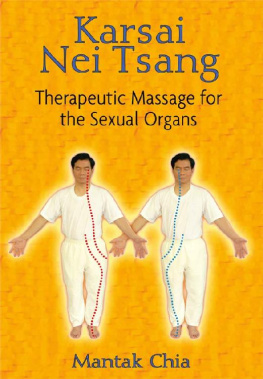
Acknowledgments
The authors would like to express our gratitude to the many Taoist masters who have generously and patiently shared their wisdom, experience, and practices over the generations. Their devotion to the Taoist arts and commitment to the unbroken oral transmission of this special lineage of Taoist knowledge has made this book possible. In particular, Master Chia would like to thank Yi Eng for his abundant teachings, which had such a deep influence on the development of the Universal Healing Tao practices.
Additionally, we would like to thank the many teachers and practitioners from the osteopathic, craniosacral, and Chinese medicine lineages for their contributions to those arts and the writing of this book. Joyce is particularly grateful to Hugh Milne, Brian ODea, and Ou Yang Min for deepening her learning and growth in these areas. She would also like to acknowledge Steve Schumacher for his valuable insights and feedback and Ching Fung Dao Shr for his profound teachings.
We are also grateful for our families, friends, and communities for their warm support as well as for their inspiration and encouragement.
We thank the many contributors essential to this books final form: the editorial and production staff at Inner Traditions/Destiny Books for their efforts to clarify the text and produce this handsome new edition of the book, and Gail Rex for her line edit of the new edition.
We wish to thank Colin Drown for his assistance in producing the earlier editions of this book, particularly for his superb editorial work and invaluable assistance with the graphics and illustrations.
And special thanks to our Thai production team: Hirunyathorn Punsan, Sopitnapa Promnon, and Udon Jandee.

List of Practices Covered in
Craniosacral Chi Kung
 Chapter 2 Awakening the Major Pumps
Chapter 2 Awakening the Major Pumps
 Chapter 3 Building Awareness and Appreciation
Chapter 3 Building Awareness and Appreciation
 Chapter 5 Balancing Emotional and Mental Flows
Chapter 5 Balancing Emotional and Mental Flows
Chapter 6 Everything Is Energy
 Chapter 7 Becoming Liquid Light
Chapter 7 Becoming Liquid Light
 Chapter 8 Cosmic Flow
Chapter 8 Cosmic Flow
 Appendix 1 Cosmic Cranial-Elemental Connections
Appendix 1 Cosmic Cranial-Elemental Connections
Putting Craniosacral Chi Kung into Practice
The information presented in this book is based on the authors personal experience and knowledge of Inner Alchemy practices. The practices described in this book have been used successfully for thousands of years by Taoists trained by personal instruction. Readers should not undertake the practices without receiving personal transmission and training from a certified instructor of the Universal Healing Tao, since certain of these practices, if done improperly, may cause injury or result in health problems. This book is intended to supplement individual training by the Universal Healing Tao and to serve as a reference guide for these practices. Anyone who undertakes these practices on the basis of this book alone does so entirely at his or her own risk.
The meditations, practices, and techniques described herein are not intended to be used as an alternative or substitute for professional medical treatment and care. If any readers are suffering from illnesses based on mental or emotional disorders, an appropriate professional health care practitioner or therapist should be consulted. Such problems should be corrected before you start Universal Healing Tao training.
Neither the Universal Healing Tao nor its staff and instructors can be responsible for the consequences of any practice or misuse of the information contained in this book. If the reader undertakes any exercise without strictly following the instructions, notes, and warnings, the responsibility must lie solely with the reader.
This book does not attempt to give any medical diagnosis, treatment, prescription, or remedial recommendation in relation to any human disease, ailment, suffering, or physical condition whatsoever.
Introduction
One winter, Joyce was at Tao Garden for a series of Universal Healing Tao retreats. Throughout the weeks of intensive Taoist practices, Master Chia frequently emphasized the importance of the cranial and sacral pumps. As a practitioner of both Craniosacral Work and Chi Kung, Joyce was deeply interested in the resonance between these two practices, and how well they complemented each other in providing a deep understanding of the foundations of health and well-being. Fascinated by modern support for the ancient practices he has devoted his life to sharing, Master Chia felt that a book about the overlap and common principles between these Eastern and Western practices would be immensely valuable to a wide audience. That book is the one you are now reading.
CHI KUNG AND CRANIOSACRAL WORK

A Common Approach
On the surface, it may seem as if there is little in common between modern science and the ancient wisdom traditions. Yet, rather than opposing each other, scientific research and new technology offer opportunities for us to enhance our understanding and appreciation of the ancient ways.
At the root of both Taoism and Craniosacral Work is a focus on cultivating harmonious, balanced movement on all levels. A core belief of both systems is that healthy internal movement automatically translates into greater harmony between the individual and his or her external environment. Based on this shared perspective, both practices emphasize a concept we refer to here as Flow: the natural, effortless unfolding of our lives in a way that moves us toward wholeness and harmony.
Flow is central to both Taoism and Craniosacral Work because it is essential to our health and well-being. Communication and coordination between all of our parts require the smooth flow of biochemical and electromagnetic signals through our fluids, tissues, and bones. The fluidity of our emotions and thoughts enables us to harmonize our inner world and to be flexible and resilient in our dealings with the outer world. The movement of chi is what moves us through life.
Both cosmologies believe that optimal Flow is synonymous with health and harmony, and that each person has an inherent capacity to healto return to the natural state of optimal Flow. Each system offers simple techniques to increase awareness of that Flow and powerful practices for balancing and enhancing it. This book draws on Taoist and Western lineagesboth ancient and modernto explore the nature of Flow and practices for improving it.

Fig. I.1. The craniosacral connection
HOW TO USE THIS BOOK
The following pages offer easy and practical exercises for finding, generating, and sustaining Flow on many levels. The book provides clear and detailed guidance for beginning practitioners, as well as a wealth of new information to deepen the understanding and experience of advanced practitioners.
Next page












 Chapter 2 Awakening the Major Pumps
Chapter 2 Awakening the Major Pumps
